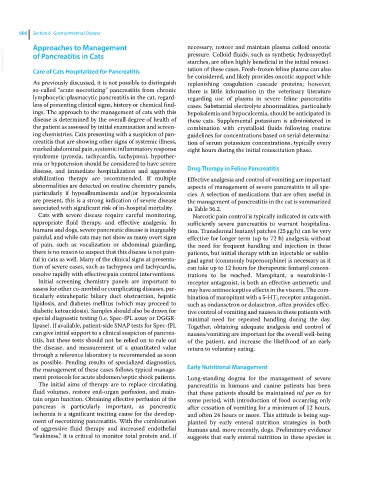Page 638 - Clinical Small Animal Internal Medicine
P. 638
606 Section 6 Gastrointestinal Disease
Approaches to Management necessary, restore and maintain plasma colloid oncotic
VetBooks.ir of Pancreatitis in Cats pressure. Colloid fluids, such as synthetic hydroxyethyl
starches, are often highly beneficial in the initial resusci
tation of these cases. Fresh‐frozen feline plasma can also
Care of Cats Hospitalized for Pancreatitis
be considered, and likely provides oncotic support while
As previously discussed, it is not possible to distinguish replenishing coagulation cascade proteins; however,
so‐called “acute necrotizing” pancreatitis from chronic there is little information in the veterinary literature
lymphocytic‐plasmacytic pancreatitis in the cat, regard regarding use of plasma in severe feline pancreatitis
less of presenting clinical signs, history or chemical find cases. Substantial electrolyte abnormalities, particularly
ings. The approach to the management of cats with this hypokalemia and hypocalcemia, should be anticipated in
disease is determined by the overall degree of health of these cats. Supplemental potassium is administered in
the patient as assessed by initial examination and screen combination with crystalloid fluids following routine
ing chemistries. Cats presenting with a suspicion of pan guidelines for concentrations based on serial determina
creatitis that are showing other signs of systemic illness, tion of serum potassium concentrations, typically every
marked abdominal pain, systemic inflammatory response eight hours during the initial resuscitation phase.
syndrome (pyrexia, tachycardia, tachypnea), hypother
mia or hypotension should be considered to have severe
disease, and immediate hospitalization and aggressive Drug Therapy in Feline Pancreatitis
stabilization therapy are recommended. If multiple Effective analgesia and control of vomiting are important
abnormalities are detected on routine chemistry panels, aspects of management of severe pancreatitis in all spe
particularly if hypoalbuminemia and/or hypocalcemia cies. A selection of medications that are often useful in
are present, this is a strong indication of severe disease the management of pancreatitis in the cat is summarized
associated with significant risk of in‐hospital mortality. in Table 56.2.
Cats with severe disease require careful monitoring, Narcotic pain control is typically indicated in cats with
appropriate fluid therapy, and effective analgesia. In sufficiently severe pancreatitis to warrant hospitaliza
humans and dogs, severe pancreatic disease is inarguably tion. Transdermal fentanyl patches (25 μg/h) can be very
painful, and while cats may not show as many overt signs effective for longer term (up to 72 h) analgesia without
of pain, such as vocalization or abdominal guarding, the need for frequent handling and injection in these
there is no reason to suspect that this disease is not pain patients, but initial therapy with an injectable or sublin
ful in cats as well. Many of the clinical signs at presenta gual agent (commonly buprenorphine) is necessary as it
tion of severe cases, such as tachypnea and tachycardia, can take up to 12 hours for therapeutic fentanyl concen
resolve rapidly with effective pain control interventions. trations to be reached. Maropitant, a neurokinin‐1
Initial screening chemistry panels are important to receptor antagonist, is both an effective antiemetic and
assess for other co‐morbid or complicating diseases, par may have antinociceptive effects in the viscera. The com
ticularly extrahepatic biliary duct obstruction, hepatic bination of maropitant with a 5‐HT 3 receptor antagonist,
lipidosis, and diabetes mellitus (which may proceed to such as ondansetron or dolasetron, often provides effec
diabetic ketoacidosis). Samples should also be drawn for tive control of vomiting and nausea in these patients with
special diagnostic testing (i.e. Spec‐fPL assay or DGGR‐ minimal need for repeated handling during the day.
lipase). If available, patient‐side SNAP tests for Spec‐fPL Together, obtaining adequate analgesia and control of
can give initial support to a clinical suspicion of pancrea nausea/vomiting are important for the overall well‐being
titis, but these tests should not be relied on to rule out of the patient, and increase the likelihood of an early
the disease, and measurement of a quantitated value return to voluntary eating.
through a reference laboratory is recommended as soon
as possible. Pending results of specialized diagnostics,
the management of these cases follows typical manage Early Nutritional Management
ment protocols for acute abdomen/septic shock patients. Long‐standing dogma for the management of severe
The initial aims of therapy are to replace circulating pancreatitis in humans and canine patients has been
fluid volumes, restore end‐organ perfusion, and main that these patients should be maintained nil per os for
tain organ function. Obtaining effective perfusion of the some period, with introduction of food occurring only
pancreas is particularly important, as pancreatic after cessation of vomiting for a minimum of 12 hours,
ischemia is a significant inciting cause for the develop and often 24 hours or more. This attitude is being sup
ment of necrotizing pancreatitis. With the combination planted by early enteral nutrition strategies in both
of aggressive fluid therapy and increased endothelial humans and, more recently, dogs. Preliminary evidence
“leakiness,” it is critical to monitor total protein and, if suggests that early enteral nutrition in these species is

